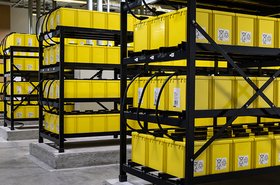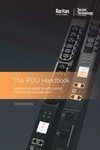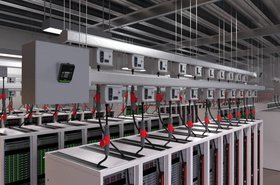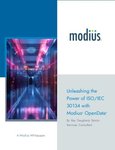As technology continues to move forward and our reliance on advanced data systems increases, data centers are continuing their dominance as the backbone of our information infrastructure.
However, many data centers still rely on legacy equipment that is outdated and energy-inefficient when housing servers and storage devices. Upfitting these facilities with modern, energy-efficient equipment such as Uninterruptible Power Supplies (UPS) and advanced cooling systems can have profound positive impacts on the electrical grid and the broader energy ecosystem.
Here are just some of the benefits existing data centers can achieve when updating facilities with continuous power as a focus.
Enhancing energy efficiency
One of the primary benefits of upgrading legacy data center equipment is the significant improvement in energy efficiency.
Older UPS systems and cooling equipment were designed in an era where energy efficiency was not a primary concern. Modern UPS systems, however, are designed to minimize energy waste. They operate at higher efficiency levels - often exceeding 95 percent - compared to older systems which might operate at 80-90 percent efficiency.
This reduction in energy waste translates directly to lower power consumption for the same amount of work, easing the burden on the electrical grid.
Similarly, modern cooling technologies such as liquid cooling and advanced air management systems can drastically reduce the energy required to maintain optimal operating temperatures for servers.
Traditional air conditioning systems are power-hungry and often inefficient, while modern cooling solutions are designed to target specific heat sources and use less power overall.
This enhanced efficiency means less energy drawn from the grid, contributing to a more stable and sustainable energy supply.
Reducing peak demand and enhancing grid stability
Data centers are typically high-density power consumers, and their demand can contribute to peak load on the electrical grid. Upgrading to more efficient equipment can help flatten this peak demand curve.
Modern UPS systems with advanced battery storage capabilities can be used for load leveling, storing energy during off-peak hours, and releasing it during peak times. This not only reduces the stress on the grid during high-demand periods but also enhances the overall stability of the electrical grid.
Moreover, advanced cooling systems can be integrated with smart grid technologies to optimize power use dynamically based on grid conditions.
During times of high grid stress, these systems can reduce their energy consumption temporarily without compromising data center operations, thereby supporting grid stability and reliability.
Lowering carbon footprint
The environmental impact of data centers is significant, with substantial energy consumption leading to high carbon emissions, especially if that electricity is sourced from fossil fuels.
Upgrading legacy equipment to energy-efficient alternatives can play a crucial role in reducing the carbon footprint of these facilities. Efficient UPS systems and cooling equipment consume less power, which means fewer greenhouse gasses are emitted from power plants. Furthermore, many modern data centers are now integrating renewable energy sources into their power supply.
Advanced UPS systems can seamlessly integrate with Battery Energy Storage Systems (BESS) solar panels and wind turbines, storing excess energy generated during peak production times and using it during periods of low generation or high demand.
This integration not only makes the data center greener but also supports the broader adoption of renewable energy, contributing to a reduction in the overall carbon footprint of the electrical grid.
Economic benefits and cost savings
Upfitting legacy data center equipment with modern, energy-efficient alternatives also yields significant economic benefits. Reduced energy consumption directly translates to lower operating costs.
Although the initial investment in new equipment can be substantial, the long-term savings in energy costs often justify the expenditure. These savings can be reinvested in further upgrades or other areas of the business, promoting a cycle of continuous improvement and efficiency.
Additionally, improved energy efficiency can help mitigate the risk of power outages and downtime, which can be extremely costly for data center operations. Reliable UPS systems and effective cooling solutions ensure that data centers remain operational even during grid disturbances, enhancing service reliability and customer satisfaction.
Supporting Smart Grid Integration
Modern data centers equipped with advanced energy management systems are better positioned to integrate with smart grid technologies.
These systems can communicate with the grid to adjust power consumption in real-time based on grid conditions, demand response signals, and energy pricing. This dynamic interaction between the data center and the grid enhances the flexibility and resilience of the power infrastructure.
For instance, during periods of low demand, data centers can ramp up their energy consumption to utilize excess grid capacity, storing it in advanced battery systems.
Conversely, during peak demand, they can reduce their draw from the grid, leveraging stored energy or optimizing their cooling systems to decrease power use. This bidirectional interaction supports a more efficient and balanced grid, reducing the need for additional power generation capacity and lowering the overall environmental impact.
Updating legacy aged-out data center equipment with modern, energy-efficient systems offers a multitude of benefits for the electrical grid. Enhanced energy efficiency reduces power consumption, alleviates peak demand constraints, and stabilizes the grid.
The environmental benefits of lower carbon emissions and the economic advantages of cost savings further underscore the value of such upgrades. Additionally, the integration with smart grid technologies positions modernized data centers as active participants in a more sustainable and resilient energy ecosystem.
As the digital infrastructure continues to expand, the importance of these upgrades will only grow, making them a crucial step towards a sustainable energy future.








